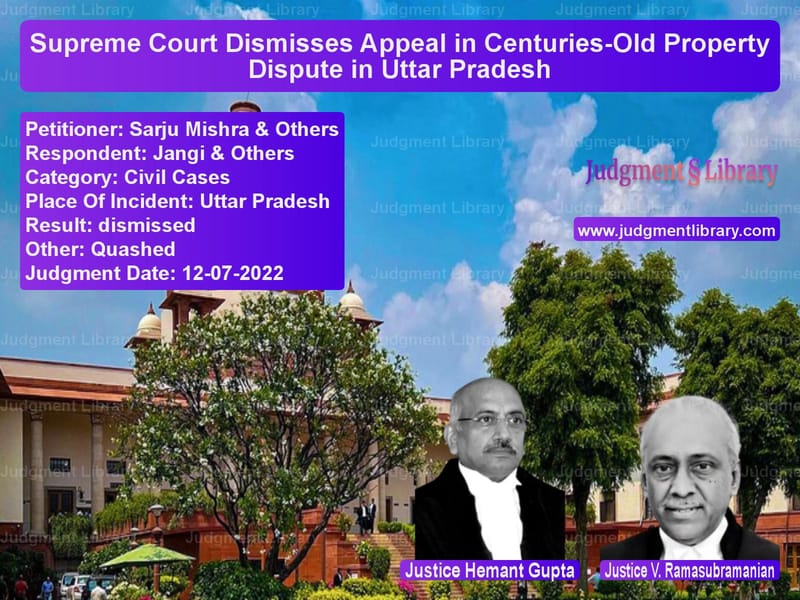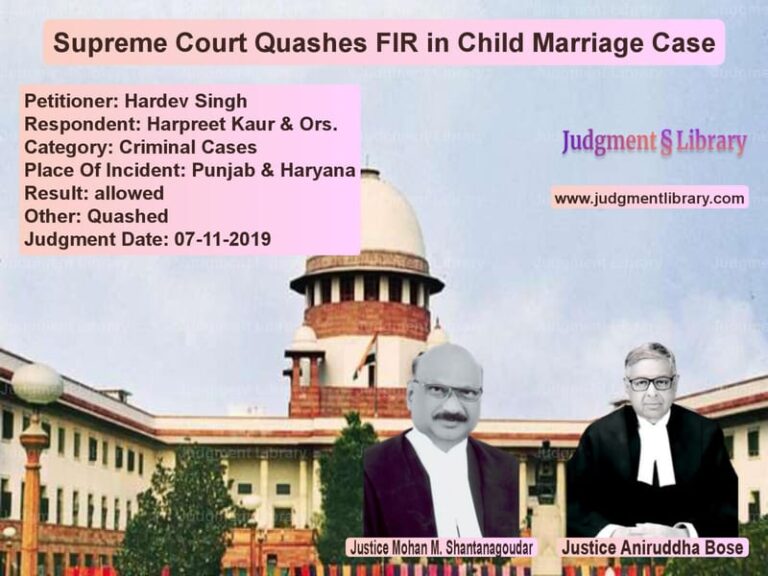Supreme Court Dismisses Appeal in Centuries-Old Property Dispute in Uttar Pradesh
The Supreme Court of India recently ruled in the case of Sarju Mishra (D) Thr. Lrs. & Ors. vs. Jangi (D) Thr. Lrs. & Ors., dismissing an appeal arising from a writ petition related to proceedings under Section 9-A(2) of the U.P. Consolidation of Holdings Act, 1953. The case involved a nearly century-old family property dispute in Uttar Pradesh, centering on the interpretation of partition decrees and succession rights.
Background of the Case
The dispute originated in 1928 when Bhagauti, a member of the family, filed a suit for partition (Suit No. 934 of 1928). Due to jurisdictional issues, the suit was transferred to the Additional Civil Court as Suit No. 119 of 1929. The parties referred the matter to arbitration, and the award was accepted, leading to a partition decree.
Following the deaths of Sita Ram and Ramesar—two of the three sons of the common ancestor, Gajadhar Misra—a disagreement arose regarding the ownership of the property. The claimants disagreed on whether Sita Ram’s one-third share should have passed to Jagesar through survivorship or if it should have been treated differently based on succession laws.
Petitioner’s Arguments (Sarju Mishra & Others)
The appellants, representing the lineage of Jagesar, contended:
- The 1929 partition decree was final and binding on all parties.
- The consolidation authorities under the U.P. Consolidation of Holdings Act had no jurisdiction to alter the terms of the civil court’s decree.
- Sita Ram’s share should have passed to Jagesar through survivorship, making their branch entitled to two-thirds of the property.
- The decision of the Deputy Director of Consolidation was erroneous and violated established property succession principles.
Respondent’s Arguments (Jangi & Others)
The respondents, representing the lineage of Bhagauti, countered:
- The partition decree of 1929 was never fully implemented.
- The consolidation proceedings were initiated much later, and new facts emerged about property possession.
- There was no clear evidence to establish who predeceased whom between Sita Ram and Ramesar, creating ambiguity in the inheritance rights.
- The Deputy Director of Consolidation correctly held that the property should be equally divided between the two branches.
Supreme Court’s Observations
The Supreme Court, after considering the extensive legal history of the dispute, made the following key observations:
- The partition decree of 1929, while final, did not conclusively resolve the issue of succession after Sita Ram’s and Ramesar’s deaths.
- The consolidation authorities were confronted with determining the factual question of the order of death, which was not decided in the 1944 civil court judgment.
- The absence of definitive proof regarding who died first made it reasonable for the consolidation authorities to distribute the property equally between both branches.
- The High Court correctly upheld the decision of the Deputy Director of Consolidation, and there was no reason to interfere with the findings.
Key Legal Precedents Considered
The Supreme Court relied on various precedents, including:
- Rameshwar Prasad v. Krishna Prasad (1963): Established that a partition decree determines shares at the time of partition but does not automatically govern future succession.
- State of U.P. v. Ram Charan (2005): Affirmed that consolidation authorities have the power to determine issues of title and succession within their jurisdiction.
- Ravindra Nath v. Raghubir Singh (1991): Held that when facts are unclear in historical disputes, the principle of equity may be applied to ensure fairness.
Final Judgment
After reviewing the entire legal history and evidence, the Supreme Court ruled:
- The appeal was dismissed.
- The decision of the Deputy Director of Consolidation, as upheld by the High Court, was confirmed.
- The property should be divided equally between the branches of Ramesar and Jagesar.
- No order was passed regarding costs.
Implications of the Ruling
The Supreme Court’s ruling has significant implications for property disputes in India:
- Reinforces the principle that consolidation authorities can resolve succession issues.
- Clarifies that partition decrees do not always settle future inheritance disputes.
- Establishes the importance of evidence in determining historical succession claims.
- Prevents prolonged litigation by upholding equitable solutions in property disputes.
The ruling ensures that similar disputes involving inheritance ambiguities are decided fairly, balancing legal precedent with equitable considerations.
Petitioner Name: Sarju Mishra & Others.Respondent Name: Jangi & Others.Judgment By: Justice Hemant Gupta, Justice V. Ramasubramanian.Place Of Incident: Uttar Pradesh.Judgment Date: 12-07-2022.
Don’t miss out on the full details! Download the complete judgment in PDF format below and gain valuable insights instantly!
Download Judgment: sarju-mishra-&-other-vs-jangi-&-others-supreme-court-of-india-judgment-dated-12-07-2022.pdf
Directly Download Judgment: Directly download this Judgment
See all petitions in Property Disputes
See all petitions in Succession and Wills
See all petitions in Judgment by Hemant Gupta
See all petitions in Judgment by V. Ramasubramanian
See all petitions in dismissed
See all petitions in Quashed
See all petitions in supreme court of India judgments July 2022
See all petitions in 2022 judgments
See all posts in Civil Cases Category
See all allowed petitions in Civil Cases Category
See all Dismissed petitions in Civil Cases Category
See all partially allowed petitions in Civil Cases Category







